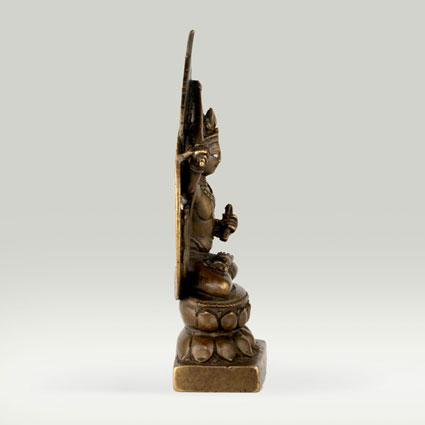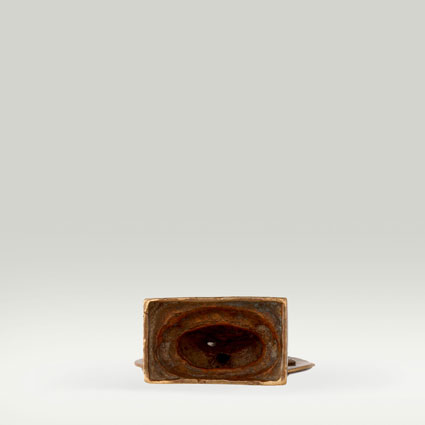ABS 136
Code: ABS 136
Country: India (north-west)
Style: Spiti / Lahaul Region
Date: 1000 - 1100
Dimensions in cm WxHxD: 7.1 x 17 x 4.3
Materials: Brass
The bottom of the pedestal is not sealed.
Sthiracakra, a form of Manjusri (Tib. 'Jam dpal), is characterized by the diamond attitude (vajraparyankasana) in which he is placed on an oval double lotus pedestal with a rectangular stand. In the raised right hand he holds his principal attribute, a sword (khadga). The left hand in front of the chest holds a manuscript (pustaka) of the Prajnaparamita Sutra. Manjusri is clad with a decorated cloth tied around the hips and secured with a beaded belt and over the shoulders he wears a veil with swirling ends. He also wears bejeweled ornaments, namely a three-pointed crown leaving long stands of his hair falling on both shoulders, a necklace with an attached pendant, the beaded sacred Thread (ratnapavita) and one pair of bracelets on the wrist. The image is encircled by an aureole (prabhamandala), the head is set off against a pointed nimbus decorated with rays.
The Sadhanamala (SM) contains eight sadhanasof Manjusri holding a sword (khadga) in the right hand and a manuscript (pustaka) of the Prajnaparamita Sutra (SM4 4, 45, 55, 56, 58, 65, 74, 80) in his left held in front of the chest or placed on a blue lily (nilotpala). The described forms of Manjusri are listed under different names: Sthiracakra (SM 44, 45); Girgariman (SM 44); Giram-isvara (SM 44); Vagisa (SM 44); Manjusri (SM 44,56, 58, 65, 80); Vagvibu (SM 44); Manjuvajra (SM 13); Arapacana (SM 45, 56, 58, 65, 80); Manjughosa (SM 74, 80); Giram-guru-manjuvara (SM 65); Manjunatha (SM 74); Vajratiksna (SM 74, 80); Prajnacakra (SM 80). In this study individual images of Manjusri holding a sword (khadga) and supporting a manuscript (pustaka) are labelled as Sthiracakra form of Manjusri shown in the diamond attitude (vajraparyankasana), as Prajnacakra form of Manjusri if shown in the noble attitude (sattvaparyankasana), or as Vajratiksna if the image appears to form part of sixteen Vajrabodhisattvas of a Mandala (NSP 19, 21; KS 2), or just as Manjusri if shown in other attitudes.
(From Wikipedia, the free encyclopedia)
Manjushree, also written Manjushri, is the bodhisattva of keen awareness in Buddhism. A disciple of the historical Buddha Shakyamuni, he represents wisdom, intelligence and realisation, and is one of the most popular Bodhisattvas following Avalokitesvara (Ch: Guan Yin).
Together with Shakyamuni and fellow disciple Samantabhadra he forms the Shakyamuni trinity (Jp: Sanzon Shaka). Manjusri is one of the Eight Wisdom Bodhisattvas and one of the Japanese Thirteen Buddhas. In Tibetan Buddhism he sometimes is depicted in a trinity with Avalokiteshvara and Vajrapani.
Manjusri is mentioned in many Mahayana sutras, particularly the Prajnaparamita Sutras. The Lotus Sutra assigns him a paradise called Vimala, which according to the Avatamsaka Sutra is located in the east. His consort in some traditions is Saraswati. He is also sometimes called Manjughosha.
Within Tibetan Buddhism, Manjushri is a tantric meditational deity or Yidam, and considered a fully enlightened Buddha.
Manjusri Mantra
Chanting the Manjusri Mantra "Om Ah Ra Pa Tsa Na Dhih" is believed to enhance wisdom and improve one's skills in debating, memory, writing, explaining etc. "Dhih" is the seed syllable of the mantra and is chanted with greater emphasis.
A male Bodhisattva, he is depicted wielding a flaming sword in his right hand, representing his realisation of wisdom which cuts through ignorance and wrong views. The scripture supported by the flower held in his left hand is the Prajnaparamita, representing his attainment of ultimate realisation and Enlightenment. Variations upon his traditional form as Manjusri include Guhya-Manjusri, Guhya-Manjuvajra, and Manjuswari, most of which are Tantric forms associated with Tibetan Buddhism. The two former appearances are generally accompanied by a shakti deity embracing the main figure, symbolising union of form and spirit, matter and energy.
Manchu
According to legend Nurhaci, a military leader of the Jurchen tribes and founder of what became the Chinese imperial Qing Dynasty, believed himself to be a reincarnation of Manjusri. He therefore is said to have renamed his tribe the Manchu.
Yamantaka
Yamantaka (meaning “terminator of Yama i.e. Death”) is seen as a wrathful manifestation of Manjushri, the buddha of wisdom. Yamāntaka (Tibetan: Shinjeshe Wylie: Gshin-rje-gshed) is a Mahayana Buddhist yidam or iṣṭadevata of the Highest Yoga Tantra class in Vajrayana, popular within the Geluk school of Tibetan Buddhism.
Role in Nepalese Mythology
According to Swayambhu Purana, the Kathmandu Valley was once a lake. It is believed that Manjushri saw a lotus flower in the center of the lake and cut a gorge at Chovar to allow the lake to drain. The place where the lotus flower settled became Swayambhunath Stupa and the valley thus became habitable.
The Newars of the Kathmandu Valley, who adhere to both Buddhism and Hinduism, revere him as the Bodhisattva of Wisdom.
de Mallmann, Marie-Thérèse, 1964. Étude iconographique sur Manjusri. Paris: École Française d’Extrème-Orient. Pp. 26-30, pl. II Prajnacakra - References to the iconography of Manjusri with sword (khadga) and manuscript (pustaka)
de Mallmann, Marie-Thérèse, 1975. Introduction à l'iconographie du tântrisme bouddhique. Paris: Adrien Mainsonneuve (Jean Maisonneuve successeur (1970). P. 252 - References to the iconography of Manjusri with sword (khadga) and manuscript (pustaka)
Sèngué, Tcheuky, 2002. Petite Encyclopédie des Divinités et symboles du Bouddhisme Tibétain. Editions Claire Lumiere . Pp. 164 / 185-191
von Schroeder, Ulrich, 1981. Indo-Tibetan Bronzes. Hong Kong: Visual Dharma Publications, Ltd.. Pp. 152-153, pls. 28D. 28E. 28F - Compare
von Schroeder, Ulrich, 2001. Buddhist Sculptures in Tibet. Vol. One: India & Nepal; Vol. Two: Tibet & China. Hong Kong: Visual Dharma Publications, Ltd.. Vol. One: India & Nepal. pp. 170-73, pls. 48E-F, 49, 50 - Compare






